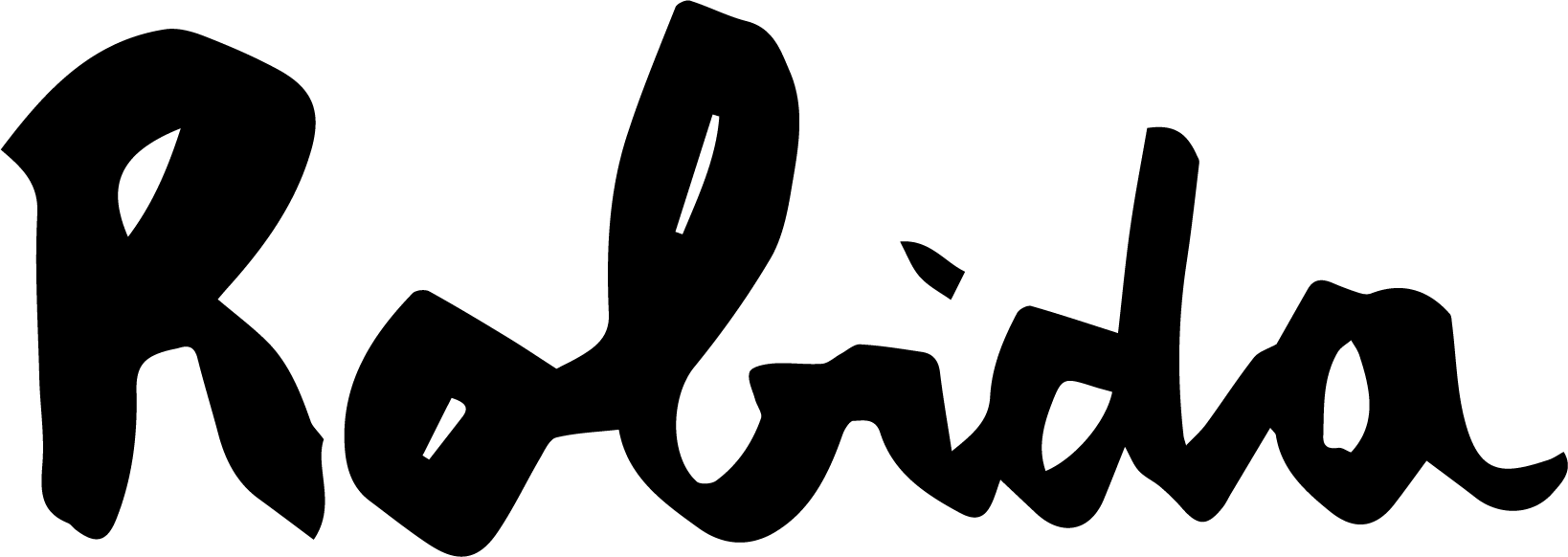Cross-border butter
On walking the frontier, exchanging food stories and making butter
1 FINDING THE BORDER
First, I look for the borderline. I start the walk from Topolò with my eyes close to the ground, paying attention to the rocks that I step on, but my steps on this first day are so heavy that my attention soon shifts to my breath. I hardly look at the path, and I don’t look at the map, I want to find the border by the indications described to me by Vida, the red pole by the road, and a concrete block next to it. After some time I reach a cross by the side of the road, and wonder whether that’s what I’m looking for, but it can’t be it. I’m so focused on the act of walking that I start becoming afraid I might miss the border. In advance, I am afraid of how much it would say about my ignorance of borders that probably emerged from having lived most of my conscious life in possession of an EU passport, something that overpowers the fact that I was born behind the Iron Curtain.
I arrive at Brieza, the top of one of the mountains where three paths cross each other. I try following the instructions of Vida, but can’t distinguish which road is going up, which is going down, and which stays on the same level, so I just follow the sign that points to Livek, my destination for today. I remember that the border is not at the top of the mountain, it is either a little bit before or after.
The path now goes downhill. After some turns it becomes much flatter and wider, the light relations change, and when I look up, I find myself in a forest of almost exclusively needle-bearing trees. The intensity of the green is not there anymore, the lower part is rather grey and airy. I remember Vida mentioning that the border is also a climatic border, and it suddenly makes sense to me that I must have crossed the border when the switch between the leafy and the needle-bearing trees took place, but this is just one of my speculations. Another one being connected to mushrooms – on the Italian side of the border the forest was so densely covered with leaves that I could not imagine finding a mushroom there. Here, the moment when I stop and lean my walking stick on a tree stump, I register one. And although I can’t discern it, this landscape suddenly feels more familiar.
Those imaginary indications of the border disappear once I have to take my phone out when I’m standing in front of a fork with no signs around – I try to understand in which direction to go, and see that the border is far behind me. Was it where the pine trees started?
On the way back, when I come close to where the border should potentially be, I try to look closely but don’t find any certain indicators. In one spot I see a second path that wanders off to the side, and wonder if that’s a clue. I look at the map on my phone, only to see that I have crossed the border already without knowing where.
The moment I realised that I had missed the border again, I knew that I would come back and that it would become a daily ritual – if not looking for the border, then crossing it.
---------
On day two, I listen to the directions more carefully, and when I am at the intersection again, I follow the sign to Livške Ravne. I pass a dense patch of fern that frames the path, thinking that it would be a perfect setting for a border passage. A few minutes later, there is a fork with no signs. I look at the map and see that I again have passed the border without noticing.
On day three, I’m trying to be even more precise with the directions. After the intersection, I take ten big steps, one metre each, and look carefully to the sides. I continue slowly turning my head from left to right with every step, and with what feels like every step, I switch between two different maps on my phone; total control.
I notice two big rocks on both sides of the path, it looks like a natural border passage, but according to the map the border is a little bit before. I make a few steps backwards, and finally the blue dot overlaps with the dashed line. I look around for the red post, but I only see it when I climb up the hill on the left side and walk around some trees.
2 FOLLOWING THE BORDER
I start the walk from the red post that is marking the border, next to is a concrete block with the numbers 34 / 13 on it.
Right side: Slovenia
Left side: Italy
The border line follows the mountain stream, or a river, Rio Zavelincelam.
Neither the border line nor the stream are straight – in their own way, so they cross each other on several occasions.
The border line seems to connect the mountain peaks with more or less straight lines like in a connect the dot type of drawing. However, at the point where I am standing, it makes a zig zag line to follow this short fragment of the mountain stream.
Mountains and rivers are both geographic characteristics that define the natural frontiers of countries. Does one of them have a priority over the other, or am I walking a part of the border defined by both the river and the mountain?
I cross the stream to be able to follow the border line, but have to go back because that side is not very walkable.
Right side: Slovenia
A very steep wall of rock, with little vegetation except moss, the dark ground is only sporadically covered with brown leaves
Left side: Italy
A less steep slope with boulders of different sizes, also covered with moss,
The ground is densely covered with brown leaves
There are many pine cones on the ground, but when I look up there’s not a single pine, except one a little bit further up that seems to br growing from a boulder in the middle of the stream.
I walk around a big rock, and a view on a waterfall opens once I have passed it, one that is several dozens of metres high, emerging from a rock wall that goes straight up from the level where I stand. For another half an hour I try to go up the steep slope next to the rock wall, but I see that I am getting away from the border line, and decide to stop. The thought of following the border to the other side does not cross my mind in that moment, but if it would have, it would be quite impossible, as the slope going up from the stream is also incredibly steep.
---------
After the failed attempt from the day before I start the next walk from my yesterday’s destination – border pole next to the block 34 / 1, the point that I first found when looking for the border line.
When I accidentally turn around, I see another pole between the trees, probably 34 / 2. It is the wrong direction, but it makes me think that it will be an easy task to connect the poles in the other direction. I examine the other side, but nothing red on the horizon there, so I just follow the direction that the blue dot on the digital map suggests.
After a couple of minutes I see the next concrete block, this time not marked with a red pole.
34
RI 1947
RS 1947
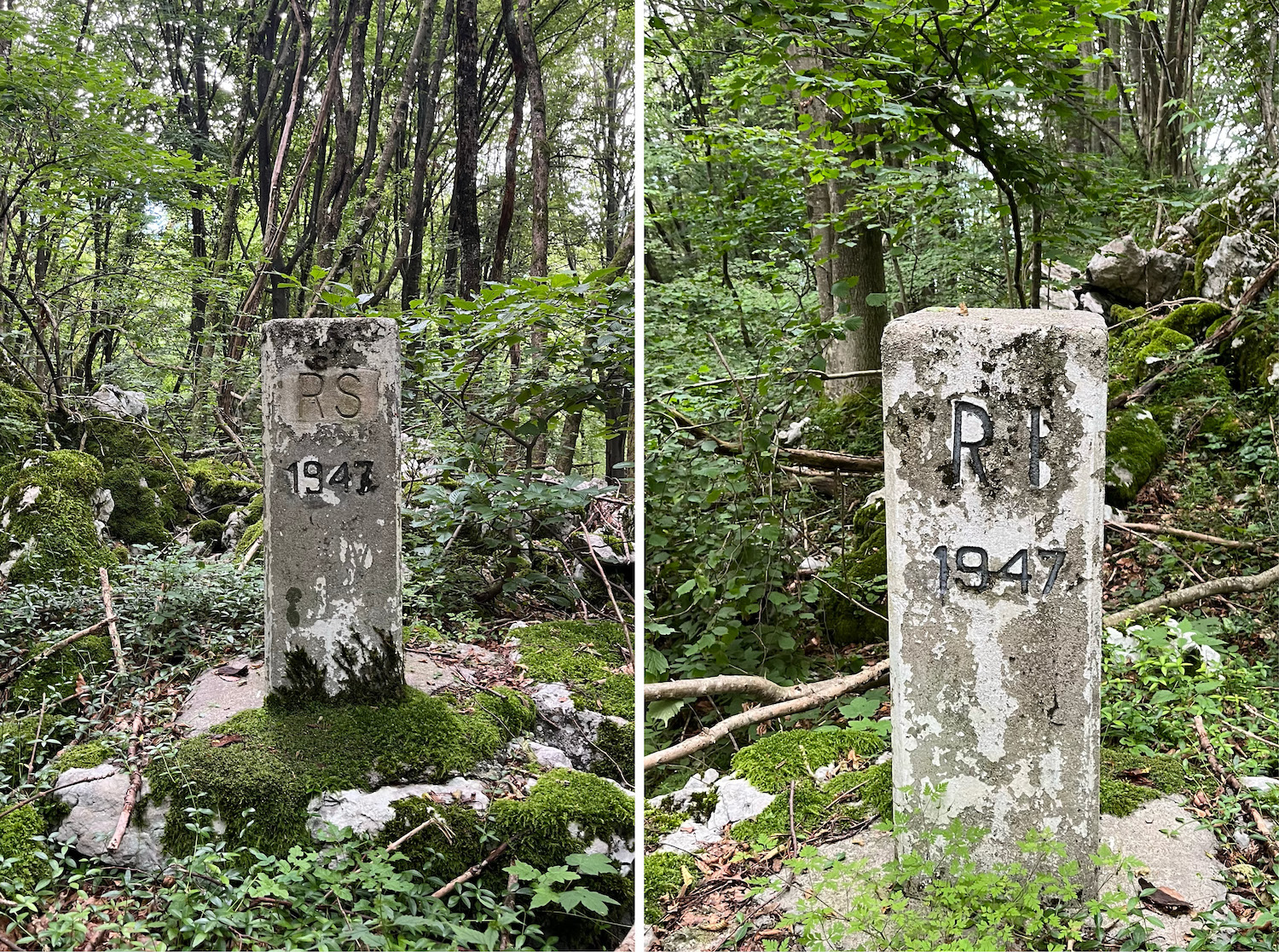
The letters S and I seem to indicate the Italian and Slovenian side. The year 1947 is the year in which the Paris Peace Treaty between Italy and the Allied Powers was signed, ending the antagonism between them.
The landscape on both sides looks pretty much the same, I continue following the digital line, without the next post in sight. When I have to climb down a steep slope, I remember my thoughts about the border connecting the tops of the mountains like dots on a drawing – not only because the steepness of the slope, but because I am now doing the same in reverse.
Left: Italy
The slope goes a little bit up and is covered with boulders. Massive leafy trees, one single pine tree.
Right: Slovenia
The slope continues in the same way, I can see the line where it ends, and trees on the background of the sky behind it. Mostly leafy trees, not that big, somewhat bushy.
In the middle, along the border on the Italian side, there is this empty wide stripe with no trees, of which I am not sure that it occurred naturally – there are no boulders and no bed of a stream, just a space that looks like it was freed up for something. Apart from that, there is no indication of the border in sight.
Left side: Italy
The slope becomes more rocky, covered by moss that is growing on the side that I’m facing when I’m looking back.
Right side: Slovenia
An earthy slope, densely covered with leaves, after the turn of the slope, I see the forest behind it, but not anymore the sky.
After climbing down a steep slope I arrive at a path that I must have crossed before on the way to Livek. I approach a sign from the back, and I think I recognise it, it’s the one that says “confin”, or “border” in Italian. I don’t see the next post, and GPS is acting up, but I see something that resembles a stream in the direction I think I should be going to, and I decide to follow it before I see the next pole up the hill.
33 / 23
I walk back a little to see if I’ve missed another block in between, because the numeration is not continuous, but I would like to figure out the system. There is nothing in sight, so I continue following the line. A wide stripe opens up before me that is following the slope down.
Left side: Italy
Little hill, a cliff that goes down, behind it the forest on the other side
Right side: Slovenia
The slope is very steep, and ends in the stream where I was walking before.
The next pole appears in the distance, and I follow what seems to be the border area freed from trees.
Left side: Italy
Three pines, quite massive, the rest is leafy trees
Right side: Slovenia
I count birch trees: one, two, three, four, five, six, number seven a bit down the slope; some pines in the background
The form of the hill is quite homogenous on both sides.
33 / 22 / (6?)
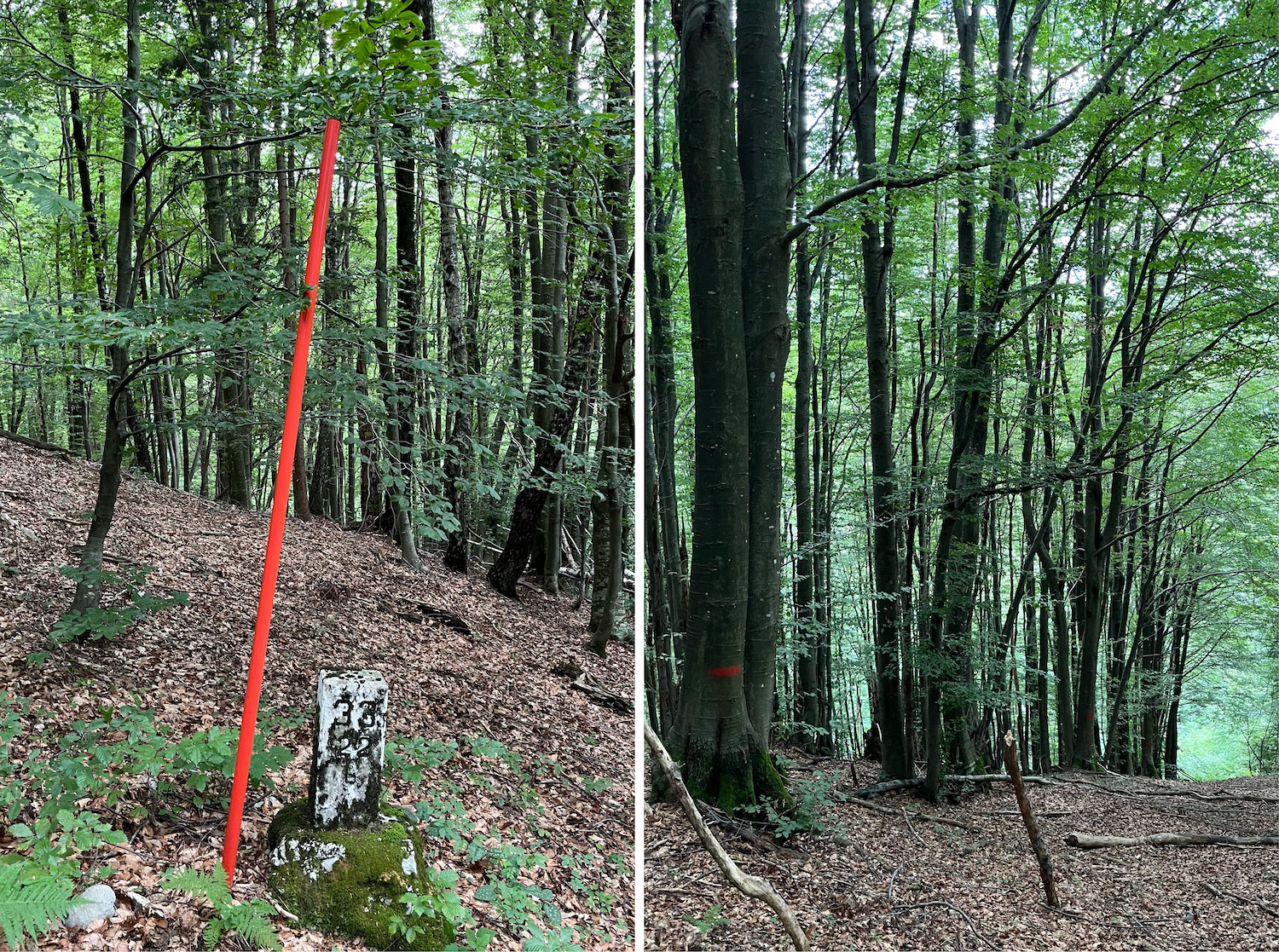
Several trees are marked with red stripes around the border line that is freed up from trees. Don’t know if they are marking the border, or whether they were marked to be cut down to keep the border area free. One tree is marked red on the Sloveian side, while on the Italian side almost every third tree has red marks.
Right side: Slovenia
Trees that I see: 5 birches, but the fifth one is dead, and in total, including the dead one, I count 11.
More pines are emerging: one, and two, very big, and nine in total.
Left side: Italy
Not a single birch, also no pines
The freed up area ends, the line I want to follow is overgrown with young leafy trees and bushes, so I walk on the right side of it. On my right (Slovenian) side are so many pines that that I stop counting. I don’t see what’s on my left as this young forest is so dense.
I arrive at a path that crosses the border, and just a few steps from where I came out of the forest is a new pole.
33 / 22 / (something that resembles a mirrored six)
The slope goes slightly down, then again up, I follow a path that I think is following the border.
Right side: Slovenia
A lot of pines, but also leafy trees, the slope goes down.
Left side: Italy
A big sunny patch with a lot of pine trees on it.
This contradicts my assumptions about the two types of threes being characteristic for one or the other side of the (climatic) border. After a few minutes I see that the path is not following the border – it just comes very close to it one point – I walk a little bit up the hill where the GPS points to the border line, and it turns out that the pines were on the Slovenian side after all. As I walk up, I already see the next border post.
33 / 21 / (something that resembles a mirrored six)
I wonder if I missed the one with a non-reversed six (behind the pine trees), and but decide to look for the next post instead, and after five minutes I stumble upon it, even though it is not marked with a red pole.
33 / 21
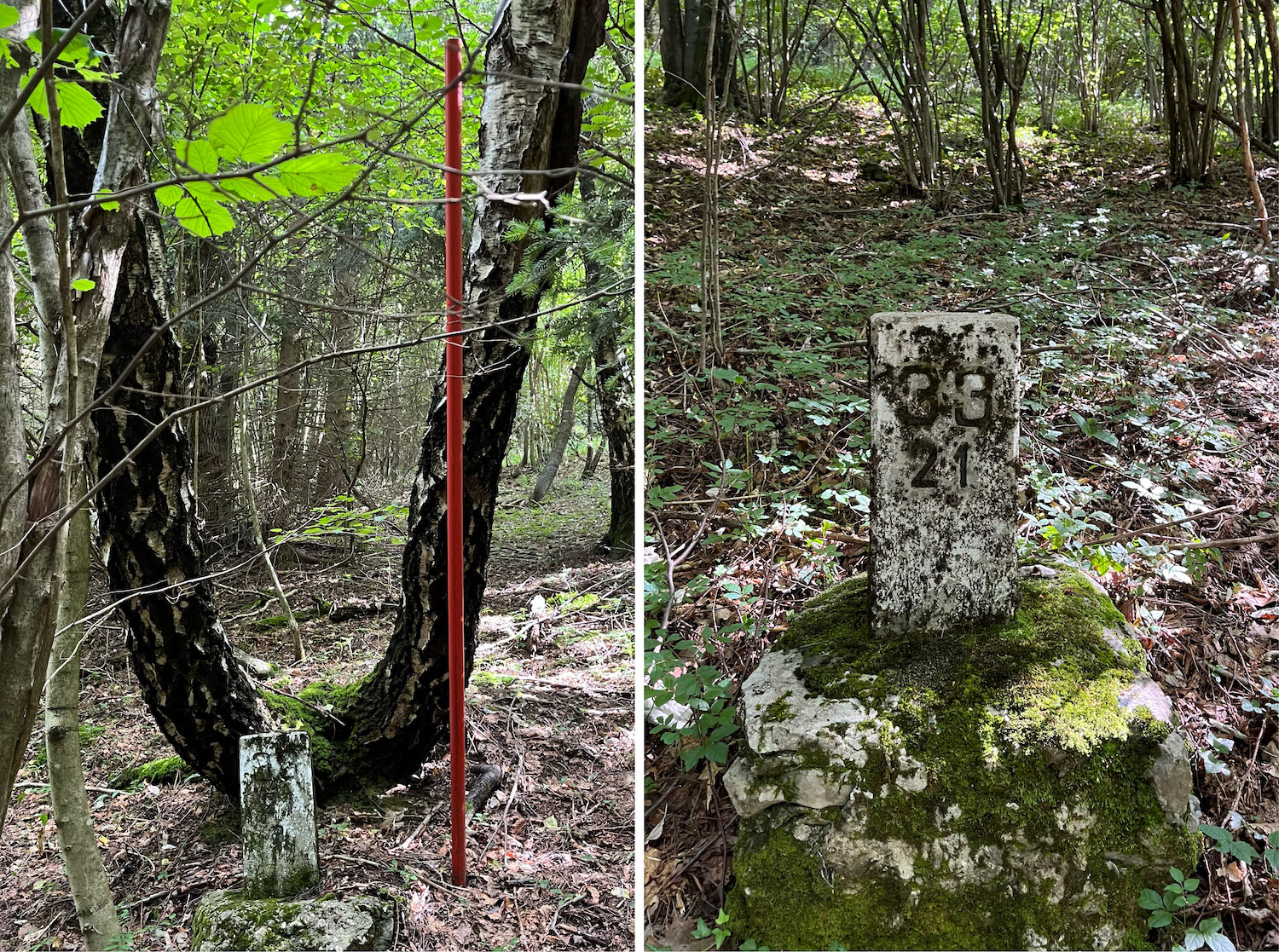
Still not having understood the presence or absence as well as the meaning of the third number, I continue. I follow the GPS arrow that leads me up the hill, but I get slightly lost, and just a few minutes later see that the border is below me. I start walking down the hill, in a part in between two steep hills, where probably the water would run down when it rains, the soil covered with leaves is very soft, and I slip many times. I start being nervous. Among other things, I slip on pine cones of which there a many on the ground, which makes me think that I must be still on the Slovenian side. I finally find a path and try to follow it, but when I turn around, I see another red pole a little further down the fold.
33 / 19
I missed just one block in between, but I am not going back to it. Instead, as it is after five and I still need to get back to Topolò, I decide to end the walk. The actual reason is that I arrived at the point of the border where it is not continuing straight, but is making quite a big loop to follow two rivers, almost perpendicular to each other, before it comes back on track close to the road with what is marked on the map as “Old Italian Customs”. If I follow the loop, I am never going to make it to the customs before dark, so I decide to take the path that will lead me to Polava and see from there. While looking for the path, I discover a little brick hut that has fallen apart, so small that it could only have been something related to the border. When I turn my head, I see another post,
33 / 18
And this is where our paths separate.
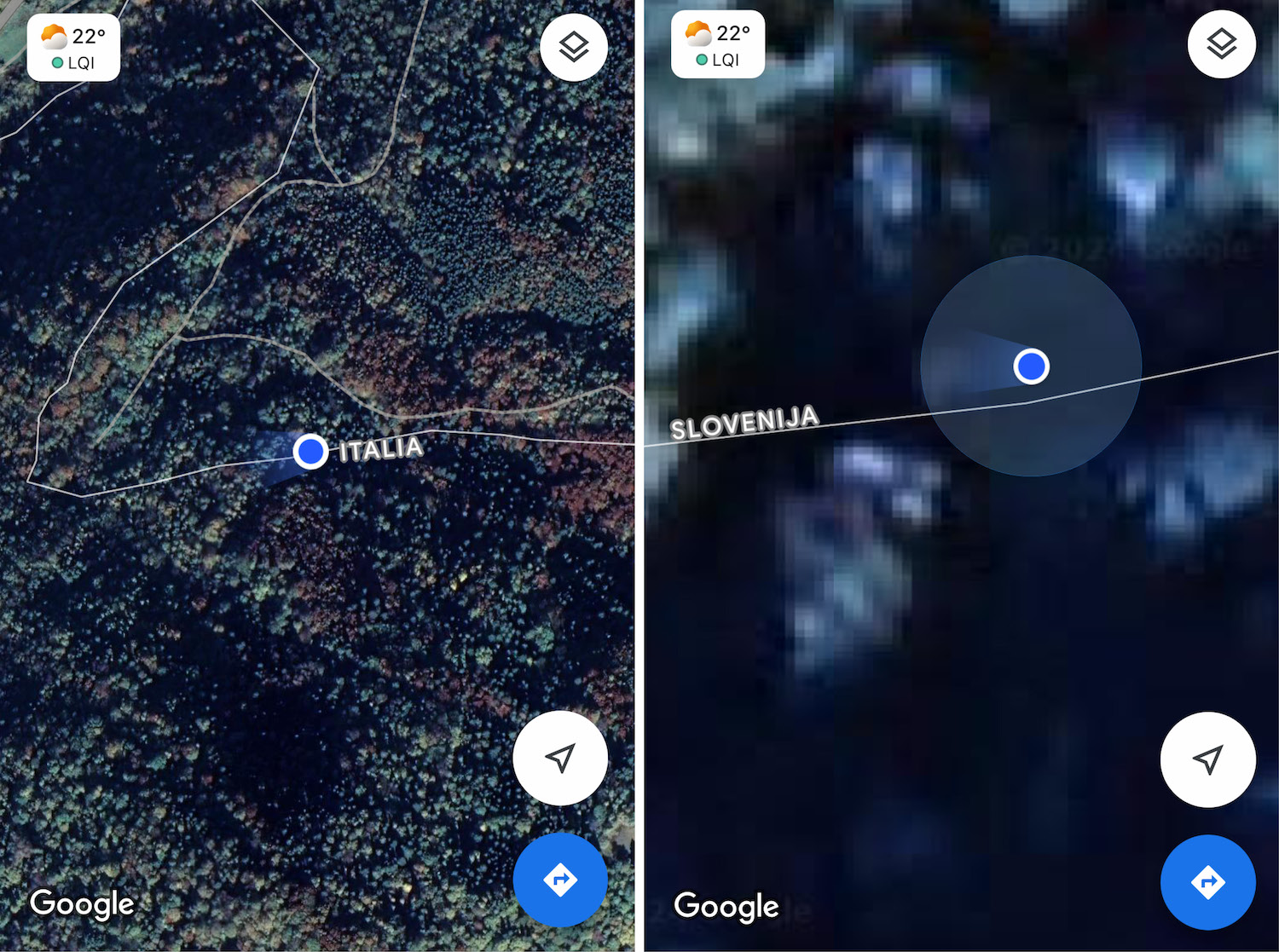
3 REACHING OVER THE BORDER
On day 7 of the border-crossing-walks I encounter a man with a dog at Brieza. He comes from the direction of Livek and turns towards Livške Ravne. We say Buongiorno. I walk a bit behind him, but close to the border, I decide to catch up with him to ask some questions. By now I know pretty well where the borderline lies, but I decide to open the conversation by asking about the location of it. After some sign language and me remembering the word Meja, he shows at the two rocks that I’ve noticed before. Without really having a common language, I try to ask about the red poles and about the times when the border was closed, but we don’t really understand each other, although after mentioning Yugoslavia my interest becomes a bit clearer to him. I’m still not sure whether people are willing to talk about this topic, so very carefully I say the word “kontrabanda” and look at him with a question in my eyes. He smiles, his answers become more lively. He starts listing things that used to be a subject of smuggling. Making the movement from the back to the front, from Italy to Slovenia, he points at his shoes, and at his clothes, with big enthusiasm he also says “television” and demonstrates how it could have been carried. In the opposite direction (from Slovenia to Italy) we go from tobacco, cigarettes and alcohol that are easy to understand, bovine to mleko (but it was not what he was talking about), to “meat” to maslo. His name is Toni.
When talking about exchange across the border, of which smuggling is a form, we are not only talking of profit (although one can’t deny that it opens up opportunities for profit), but also about bordering practices that are built on the accessibility and distinctiveness of products. If we zoom in on the exchange that had taken place between Topolò and the areas it borders in Slovenia or former Yugoslavia, we see how this distinctiveness is rooted in the landscape. When hearing that wine and dairy products is something that has been traditionally exchanged, I get excited because there not two products that are more representative of the landscape and its climatic conditions. The word terroir is something that we know from wine context. C. van Leeuwen describes terroir is an ecosystem, in a given place, including factors like climatic conditions, […] geography and topography, as well as soil characteristics.[1] While the character of the place when it comes to wine was described as terroir already since several centuries, more recently, starting from the 20th century, it was also applied to cheese. Cheese is a very complex product that does not only stem from the collaboration between the landscape, the animal grazing in it, and the human directing the access on enzymes and bacteria – it also goes through the process of ripening, influenced by many factors that make up the terroir. Butter is something very simple, perhaps not as simple as milk, but it is still a product that manifests the animal-human-landscape collaboration, and is a product that very often talks about an identity of a place. Butter and olive oil that create a divide between cultures are strong symbols of regional and national identity. In countries such as Ireland or the UK where butter is central to it’s national identity – and can support the need of reinforcing it in times when a nation is questioning what it is to be, in this case, British in the course of the Brexit debate. In Ireland, one of the most successful brands was created by packaging ‘Irishness’ to sell it internationally in a form of butter, a product that turns rain that nurtures the grasses into something that can be exported. [2]
I zoom back into the local context of Topolò, where the frontier experienced different types of bordering practices, from facilitating exchange between two regions separated by a climatic border to less legal exchange between a socialist and capitalist countries. Without going into much detail on smuggling as a practice of solidarity, which has already been done by Aljaž in his text Tihotapljenje kot praksa skupnostnosti in solidarnosti [3], I want to touch upon the importance of the exchange it enables and question how it can be continued when there’s no more border to cross.
I met Toni when I was on my way to Martina in Livške Ravne. Last time I was there she gave me a little bit of goat milk, and while I was walking back to Topolò, with my fabric bag dangling from side to side on my back, the milk turned to butter. The idea to use the simple act of walking across the border to transform a product of little value to one of much higher one that used to be worth smuggling is something that I want to do more often – like this, the butter does not only become something that is represents the landscape over the border, but also the border escape itself. Because the idea of exchange is important to me, I am coming back to Martina with honey from Topolò, and I will receive homemade drinks from her that I will bring back. The week before, I attempted another exchange at the dairy farm in Idrska Planina, where I was going for cow milk, or rather the cream of it. Sabit, a Bosnian man working there for the summer, makes his own butter at the farm, but thinks along with me about how I could get cream to use as a base for butter – he’s sceptical about the process, but gives me some milk from the day before to try. The process does indeed go less smooth than with goat milk, but when I’m back in Topolò, I see a big clump of bitter in the thermos.
[1] C. van Leeuwen, Managing Wine Quality (Second Edition), 2022
[2] How Baileys Irish Cream is rooted in an 18th Century Satanic Sex Cult, The Blindboy Podcast, Season 1, Ep. 274, 2022
[3] Aljaž Škrlep, Tihotapljenje kot praksa skupnostnosti in solidarnosti in Radio Tihotapci, 2022.
Here you can listen to the conversation between Anastasia and Vida on Anastasia's residency experience in Topolò!
Anastasia's residency is part of the project Sensing Soils, supported by Regione Friuli-Venezia Giulia.

